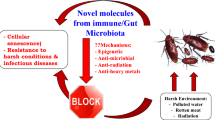Abstract
Male beetles of the larger grain borer,Prostephanus truncatus Horn (Coleoptera: Bostrichidae) were shown to produce material causing an electroantennographic (EAG) response from both male and female beetles. Volatiles from mixed sex cultures were collected on Porapak Q and fractionated by liquid chromatography (LC) with gradient elution. The total volatiles and the fractions were analyzed by gas chromatography (GC) linked to EAG, and two compounds eluting in the same LC fraction elicited EAG responses from male and female beetles. These were assumed to be components of the male-produced aggregation pheromone. Amounts of these compounds obtained were very low and less than 10−3 times the amounts of the aggregation pheromone components produced by the related species,Rhyzopertha dominica, under similar conditions. The most abundant of these EAG-active compounds was identified as 1-methyiethyl (2E)-2-methyl-2-pentenoate by comparison of its GC retention times and mass spectrum with those of synthetic analogs. The synthetic compound elicited electrophysiological and behavioral responses in both male and female beetles significantly greater than those to structural analogs. This compound is attractive toP. truncatus beetles in the field, and has been given the trivial name of “trunc-call 1”.
Similar content being viewed by others
References
Angst, M.E., andLanier, G.N. 1979. Electroantennogram responses of two populations of Ips pini (Coleoptera: Scolytidae) to insect-produced and host tree compounds.J. Chem. Ecol. 5:131–140.
Chan, K.C., Jewell, R.A., Nutting, W.H., andRapoport, H. 1968. The synthesis and stereochemical assignment ofcis- andtrans-2-methyl-2-pentenoic acid and the corresponding esters, aldehydes, and alcohols.J. Org. Chem. 33:3382–3385.
Dendy, J., Dobie, P., Saidi, J.A., Smith, J.L., andUronu, B. 1989a. Trapping the larger grain borerProstephanus truncatus in maize fields using synthetic pheromones.Entomol. Exp. Appl. 50:241–244.
Dendy, J., Dobie, P., Saidi, J., andSherman, C. 1989b. The design of traps for monitoring the presence ofProstephanus truncatus (Horn) (Coleoptera: Bostrichidae) in maize fields.J. Stored Prod. Res. 25:187–191.
Dendy, J., Saidi, J.A., Smith, J.L., andUronu, B. 1991. Trials to assess the effectiveness of new synthetic pheromone mixtures for trappingProstephanus truncatus.J. Stored Prod. Res. 27:69–74.
Duncan, D.B. 1955. Multiple range and multipleF tests.Biometrics 11:3382–3385.
Dunstan, W.R., andMagazini, I.A. 1981. Outbreaks and new records. Tanzania. The larger grain borer on stored products.FAO Plant Prot. Bull. 29:80–81.
Fisher, W.S. 1950. A review of the North American species of beetles belonging to the family Bostrichidae. U.S. Department of Agriculture, Miscellaneous Publication No. 698. 157 pp.
Hall, D.R., Beevor, P.S., Cork, A., Nesbitt, B.F., andVale, G.A. 1984. A potent olfactory stimulant and attractant for tsetse isolated from cattle odours.Insect Sci. Appl. 5:335–339.
Hassner, A., andAlexanian, V. 1978. Direct room temperature esterification of carboxylic acids.Tetrahedron Lett. 19:4475–4478.
Harnisch, R., andKrall, S. 1984. Further distribution of the larger grain borer in Africa.FAO Plant Prot. Bull. 32:113–114.
Harris, W.E., andHabgood, H.W. 1966. Programmed Temperature Gas Chromatography. John Wiley & Sons, New York.
Hodges, R.J. 1986. The biology and control ofProstephanus truncatus (Horn) (Coleoptera: Bostrichidae)-destructive storage pest with an increasing range.J. Stored Prod. Res. 22:1–14.
Hodges, R.J., Dunstan, W.R., Magazini, I., andGolob, P. 1983a. An outbreak ofProstephanus truncatus (Horn) (Coleoptera: Bostrichidae) in East Africa.Prot. Ecol. 5:183–194.
Hodges, R.J., Hall, D.R., Golob, P., andMeik, J. 1983b. Responses ofProstephanus truncatus to components of the aggregation pheromone ofRhyzopertha dominica in the laboratory and the field.Entomol. Exp. Appl. 34:266–272.
Hodges, R.J.,Cork, A., andHall, D.R. 1984. Aggregation pheromones for monitoring the greater grain borer,Prostephanus truncatus. British Crop Protection Conference-Pests and Diseases, Brighton, pp. 255–259.
Kega, V.K., andWarui, C.W. 1983.Prostephanus truncatus in Coast Province, Kenya.Trop. Stored Prod. Inf. 46:2.
Krall, S. 1984. A new threat to farm-level maize storage in West Africa:Prostephanus truncatus (Horn) (Coleoptera: Bostrichidae).Trop. Stored Prod. Inf. 50:26–31.
McFarlane, J.A. 1988. Pest management strategies forProstephanus truncatus (Horn) (Coleoptera: Bostrichidae) as a pest of stored maize grain: present status and prospects.Trop. Pest. Manage. 34:121–132.
McGuire, J.U., andCrandall, B.S. 1967. Survey of insect pests and plant diseases of selected food crops of Mexico, Central America and Panama. U.S. Department of Agriculture. 157 pp.
Moorhouse, J.E., Yeaden, R., Beevor, P.S., andNesbitt, B.F. 1969. Method for use in studies of insect chemical communication.Nature 223:1174–1175.
Muhihu, S.K., andKibata, G.N. 1985. Developing a control programme to combat an outbreak ofProstephanus truncatus (Horn) (Coleoptera: Bostrichidae) in Kenya.Trop. Sci. 25:239–248.
Nagaoka, H., andKishi, Y. 1981. Further studies on rifamycin S.Tetrahedron 37:3873–3888.
Nesbitt, B.F., Beevor, P.S., Hall, D.R., Lester, R., Sternlicht, M., andGoldenberg, S. 1977. Identification and synthesis of the female sex pheromone of the citrus flower moth,Prays citri.Insect Biochem. 7:355–359.
Nielsen, A.T., andHoulihan, W.J. 1968. The aldol condensation.Org. React. 16:1–438.
Pearl, I.A. 1963. Vanillic acid.Org. Syn. Coll. 4:972–973.
Shires, S.W., andMcCarthy, S. 1976. A character for sexing live adults ofProstephanus truncatus (Horn) (Bostrichidae, Coleoptera).J. Stored Prod. Res. 12:273–275.
Williams, H.J., Silverstein, R.M., Burkholder, W.E., andKhorramshahi, A. 1981. Dominicalure 1 and 2: Components of aggregation pheromone from male lesser grain borerRhyzopertha dominica (F.) (Coleoptera: Bostrichidae).J. Chem. Ecol. 7:759–780.
Author information
Authors and Affiliations
Rights and permissions
About this article
Cite this article
Cork, A., Hall, D.R., Hodges, R.J. et al. Identification of major component of male-produced aggregation pheromone of larger grain borer,Prostephanus truncatus (Horn) (Coleoptera: Bostrichidae). J Chem Ecol 17, 789–803 (1991). https://doi.org/10.1007/BF00994201
Received:
Accepted:
Issue Date:
DOI: https://doi.org/10.1007/BF00994201




